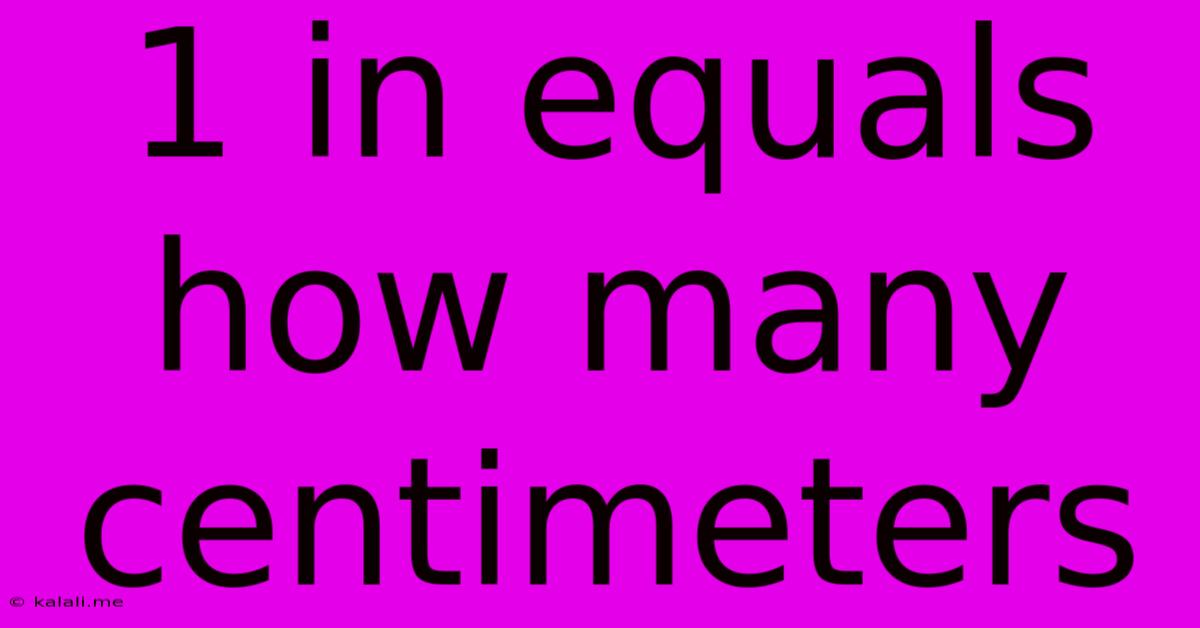1 In Equals How Many Centimeters
Kalali
May 10, 2025 · 3 min read

Table of Contents
1 Inch Equals How Many Centimeters? A Complete Guide to Unit Conversion
Meta Description: Learn the exact conversion of inches to centimeters and explore handy tips and tricks for easy unit conversions in your daily life. This comprehensive guide covers everything you need to know about this common measurement conversion.
Understanding unit conversions is crucial in various aspects of life, from cooking and crafting to engineering and design. One common conversion that often arises is converting inches to centimeters. This guide will delve into the precise conversion factor and provide helpful methods to make these conversions effortlessly.
The Exact Conversion: Inches to Centimeters
The fundamental relationship between inches and centimeters is based on the metric system. One inch is exactly equal to 2.54 centimeters. This is a fixed conversion factor, universally accepted and used across various fields.
Therefore, if you have 'x' inches, the equivalent in centimeters is calculated as: x inches * 2.54 cm/inch = y centimeters.
Practical Applications and Examples
Let's explore some practical scenarios where understanding this conversion proves valuable:
-
Cooking and Baking: Many international recipes use the metric system. Knowing that 1 inch is 2.54 centimeters helps you accurately convert measurements when following recipes that use centimeters or millimeters. For example, if a recipe calls for 5 cm of butter, it's equivalent to approximately 1.97 inches (5 cm / 2.54 cm/inch ≈ 1.97 inches).
-
Sewing and Crafting: Precise measurements are essential in sewing and other crafts. Converting inches to centimeters ensures accurate cutting and fitting, leading to better results in your projects. A pattern calling for 12 inches of fabric would require 30.48 centimeters (12 inches * 2.54 cm/inch = 30.48 cm).
-
Engineering and Design: In engineering and design, accurate measurements are paramount. Converting between inches and centimeters ensures compatibility and precision when working with international standards and collaborating with teams using different measurement systems.
-
Everyday Measurements: Even in everyday life, understanding this conversion can be helpful. For instance, measuring the height of a child, the dimensions of a piece of furniture, or the length of a piece of string might require switching between inches and centimeters depending on the available measuring tools.
Beyond the Basics: Working with Fractions and Decimal Places
While the basic conversion is straightforward, you might encounter scenarios involving fractions of an inch. In such cases, you simply convert the fractional part to a decimal and then multiply by 2.54. For example:
- 3 ½ inches: Convert 3 ½ to 3.5. Then, 3.5 inches * 2.54 cm/inch ≈ 8.89 cm
Similarly, you can easily convert centimeter measurements to inches by using the reverse calculation: y centimeters / 2.54 cm/inch = x inches.
Using Online Converters and Calculators
Numerous online converters are readily available if you need to perform multiple or complex conversions quickly. These tools can save time and reduce the risk of manual calculation errors. However, understanding the fundamental conversion factor remains crucial for verifying results and grasping the underlying principles.
Conclusion
Knowing that 1 inch equals 2.54 centimeters is a fundamental skill with far-reaching applications. Mastering this conversion empowers you to navigate various situations requiring accurate measurements, fostering efficiency and precision in your work and daily life. Remember to always double-check your calculations, especially when precision is critical.
Latest Posts
Latest Posts
-
How Much Is 50 Gallons Of Water
Jun 30, 2025
-
How Many Laps Around A Football Field Is A Mile
Jun 30, 2025
-
The Ability To Say Clever And Funny Things
Jun 30, 2025
-
How Many Cups Are In A Pound Of Lard
Jun 30, 2025
-
Why Did Jerry Thompson And Kelly Nelon Divorce
Jun 30, 2025
Related Post
Thank you for visiting our website which covers about 1 In Equals How Many Centimeters . We hope the information provided has been useful to you. Feel free to contact us if you have any questions or need further assistance. See you next time and don't miss to bookmark.